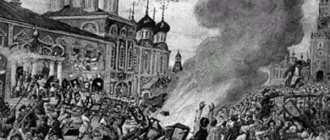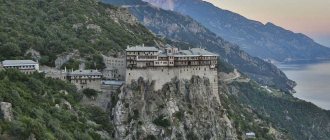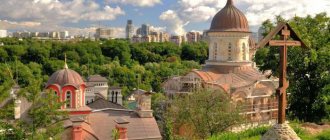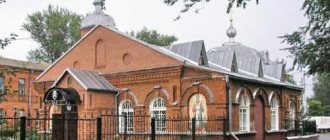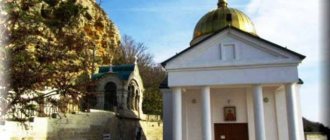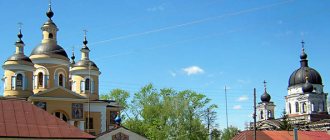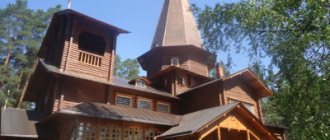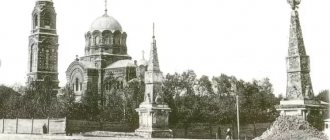| Holy Trinity Seraphim-Diveevo Convent |
Seraphim-Diveevo Convent in the Name of the All-Holy Trinity
of the Nizhny Novgorod Diocese
- Address: Russia, 607320, Nizhny Novgorod region, Diveevsky district, village. Diveevo
- Tel.: +7 (83134) 4-34-45
- Official site:
- Yandex.Map, Google map
Formation of a community
The monastery was founded in the second half of the 18th century by the Venerable nun Alexandra (Melgunova), who was a wealthy landowner in the world. The Mother of God Herself commanded her to become the founder of the new, fourth, inheritance of the Mother of God on earth
(after Iberia, Athos and Kiev). Around 1760, the ascetic stopped in the village of Diveevo, where she received a miraculous notification that this was the place chosen by the Most Pure One. In 1767, at the expense of the saint, a stone church was founded in honor of the Kazan Icon of the Mother of God. The main altar was consecrated in 1772, the left chapel in the name of St. Nicholas the Wonderworker - four years later, and the right chapel in the name of the first martyr Archdeacon Stephen - in 1779 [1]. From Kazan the saint brought an exact copy of the icon of the Kazan Mother of God, from Kyiv - particles of holy relics, from Moscow - bells, and from the Sarov Monastery - an old iconostasis. In 1788, the local landowner Zhdanova, having heard about the monastery promised from above to Mother Alexandra, donated 1,300 square meters. fathoms of his estate land near the Kazan Church for the establishment of a community. The Monk Alexandra built three cells there and surrounded the buildings with a wooden fence. She occupied one cell with a novice, invited three more novices to live in another, and gave the third to pilgrims going to Sarov. The community lived according to the strict Sarov charter. The mentor of the sisters was the Sarov elder Pachomius. Food was brought once a day from the Sarov meal. The sisters sewed and knitted for the Sarov brethren, and led a non-covetous life of labor and prayer. Before her death in 1789, Mother Alexandra asked the young hierodeacon of the Sarov Hermitage, the future Venerable Seraphim, to take care of her community.
After the death of the founder of the community, the young monastery was headed by one of the three remaining sisters, Anastasia Kirillovna, who over the course of seven years gathered up to 52 sisters into the community. Since 1796, after the death of Anastasia Kirillovna, the community was headed by Ksenia Mikhailovna Kocheulova. She was so strict that in the first year of her administration, 40 people left the community, but then new ones began to arrive.
The Monk Seraphim of Sarov wanted to soften the severity of the charter of the Kazan community, but Mother Ksenia did not agree, saying that the charter was given by the Sarov builder Pachomius. Then, in 1826, at the direction of the Mother of God, Saint Seraphim established another community near the Diveyevo Kazan community, which received the name “Melnichnaya,” with a softer charter. The founding day of this monastery is considered to be December 22 of that year. According to the instructions of the Most Pure One, eight sisters from the Kazan community should have been transferred to it. It was ordered to build two churches - in honor of the Nativity of Christ and the Nativity of the Blessed Virgin Mary, to dig a ditch and pour a rampart around the monastery, and also to build a feeding mill.
After the repose of St. Seraphim, the abbot of the Trinity-Sergius Lavra, St. Anthony (Medvedev), took over the care of the Diveyevo community. In 1842, the Mill community was annexed to the Kazan community.
The heyday of the monastery
On February 10, 1861, by decree of the Holy Synod, the Diveyevo women's community was elevated to the level of a third-class dormitory monastery. The charter of the monastery was taken from the Melnichnaya community, which is why the monastery began to be called Seraphim-Diveevsky. During the years of management of the monastery by Abbess Maria (Ushakova), the monastery acquired its unique architectural appearance, which was preserved at the beginning of the 21st century. The Trinity Cathedral predicted by St. Seraphim (1875), the abbot's building (1885) with the Church of Equal-to-the-Apostles Mary Magdalene (1901), the refectory church of the blessed Prince Alexander Nevsky (1895), the bell tower (1902) and about 30 buildings for obediences and housing for sisters.
The main income of the monastery came from numerous workshops: handicrafts, where they embroidered with gold and silk, as well as satin stitch on cambric and linen, painting, lithography, where they also engaged in photography and metachromotyping (translating engraved paintings onto tin, stone and wood), metal carving and bookbinding business. The monastic needs were provided by bread, prosphora, candles, tailoring, vestments, and manate [2] obediences. The scroll shop sewed scrolls (shirts) for the Sarov brethren, up to 400 pieces annually. Many buildings were occupied by economic departments: glass, painting and painting, cellar, vegetable gardening, gardening, milling. The monastery had a large orchard. There was a threshing building and two granaries. The meal, prosphora and almshouse were supplied with water from a pumping station, which supplied the entire monastery and two baths with the required amount of water.
Separate buildings housed an almshouse for seriously ill and elderly sisters, a dental office and a hospital. At the monastery, a shelter was set up for girls, mainly orphans, where they were taught by priests, and the sisters of the monastery taught needlework and sacred singing. Outside the fence, the monastery owned hotels (both for nobles and common people), a horse yard with the necessary buildings: a forge and two huts for workers, as well as five houses for priests and deacons with outbuildings and a garden.
By the beginning of the century, the Seraphim-Diveevo Monastery had become the largest monastic hostel. On August 2, 1903, during the Sarov celebrations on the occasion of the glorification of St. Seraphim, the monastery received the passion-bearers of Emperor Nicholas II with Empress Alexandra Feodorovna and members of the royal family. The following year, after the death of Abbess Maria, on her instructions, the sisters elected nun Alexandra (Trakovskaya) as Abbess Treasurer, who remained the abbess of the monastery until its closure.
Closure and ruin
In 1919, the monastery was transformed into a labor artel. Divine services in churches still continued, but lands, farms and farms were confiscated. The sisters had to bear labor obligations: work on nationalized land, receiving rations for it. The closure of the Seraphim-Diveevo Monastery followed on September 27, 1927.
During the years of Soviet power, many monastery buildings were destroyed, the Holy Kanavka was covered with earth and debris.
Renaissance
The revival of church life in Diveyevo began in 1988, when believers were allowed to buy a house above the Kazan spring and rebuild it for a church. On Lazarus Saturday, April 22, 1989, the wooden church was consecrated in honor of the Kazan Icon of the Mother of God. On April 31, 1990, on the day of the Praise of the Most Holy Theotokos, the Trinity Cathedral was re-consecrated. From January 1, 1991, all statutory services began to be held there daily.
On July 18, 1991, the Holy Synod decided to renew the Seraphim-Diveyevo Monastery [3]. On July 30 of the same year, the newly discovered holy relics of St. Seraphim of Sarov solemnly arrived in Diveevo.
Statistics
- 1796 - 52 sisters [4]
- 1825 - 50 sisters [4]
- 1833 - in the Mill community: 19 cells, 73 sisters [4]
- 1917 - according to the list: 270 nuns, 1474 novices (while the population of the village of Diveevo was 520 people) [4]
- OK. beginning 2000s - more than 400 nuns [5]
- OK. con. 2010s - in the monastery and on its 19 hermitages and farmsteads: 36 churches with 82 altars; OK. 500 nuns [6]
| Trinity Cathedral of the Seraphim-Diveevsky Monastery |
History of the formation of the monastery
The monastery chronicle contains the history of its existence, which tells that the founder of the monastery was the noblewoman Agafya Semyonovna Melgunova (nee Stepanova). Having become a widow early, she and her three-year-old daughter went to Kyiv, to the Florovsky Monastery.
Takes monastic vows under the name Alexandra. In a vision, the Mother of God blesses mother to travel in search of a holy land to found a monastery. In the village of Diveevo, the Mother of God indicates that the place has been found.
Having lost her only daughter, Alexandra heads to her native land. Sells estates, releases serfs. By 1767 he returned to Diveevo. Having built a cell in the courtyard of priest Vasily Dertev, she begins a new life, entirely devoted to the service of the Mother of God.
Mother Alexandra erects a stone temple in the name of the Kazan Mother of God on Diveyevo land to replace the dilapidated building of the Church of St. Nicholas the Wonderworker. Later, next to the church, a women’s community is established, which lives according to the difficult rules of the Sarov monastery.
On June 13, 1879, the founder died. First Father Pachomius took charge of the women's monastery, then Seraphim of Sarov.
Since 1825, Father Seraphim has been establishing a new Seraphim community. The community lives according to the charter, which the Mother of God gave, telling it to St. Seraphim. A windmill - a feeder - is being built here. In 1829, Seraphim blesses the sisters for digging the Mother of God ditch, which is now a place of pilgrimage for pilgrims.
In 1829, the Church of the Nativity of Christ was added to the Kazan Church. In 1830, a temple was built under it in honor of the Nativity of the Virgin Mary, which became the place of worship for the sisters of both women's communities: Kazan and Melnichnaya Seraphimo-Diveevskaya.
After his death, landowner Nikolai Aleksandrovich Motovilov becomes the breadwinner of Seraphim’s community. Father Seraphim heals him, who is seriously ill. The elder bequeathed to him to take care of the Diveyevo sisters and serve the monastery.
The Diveyevo monastery becomes widely known, where widows and girls from various parts of Russia come to live. In 1842, the communities united into one - Serafimo-Diveevskaya.
From 1848 to 1875, the stone five-altar Trinity Cathedral was built here. The territory is being improved. By the beginning of the 20th century, the following were operating in the monastery: the Trinity Cathedral, the Nativity and Tikhvin churches, the Preobrazhenskaya church in the cemetery, house churches in the Igumensky, Refectory, and Almshouse buildings.
Photo of the Diveyevo Monastery of Seraphim of Sarov during the Tsar’s visit
During the revolutionary years, a labor artel was opened on the territory of the monastery. In 1927, the monastery was closed, desecrating the temples. The famous Kazan Church is closed after 10 years.
The revival of the monastery began in 1990. Trinity Cathedral is consecrated. In 1991, the grave of Mother Alexandra was restored and the relics of Seraphim were transferred to the cathedral. Alexandra's relics were transferred to the Church of the Nativity of the Virgin Mary in 2000. The Diveyevo Monastery of Seraphim of Sarov begins to operate, multiplying the power of Orthodoxy.
Why did Catholics sell the lands and buildings of the abbey?
We have heard assumptions made by some (obviously, not without reason) that the Catholics who previously owned this land, having learned about the expansion of the construction of the airport in Newark and the possible development of a training airfield in the immediate vicinity of the abbey, hastened to get rid of the property, receiving money for the sale at least some means. Apparently, they feared that the state might simply take these lands without any compensation for construction needs. The Orthodox were not afraid to buy these lands, trusting in God’s providence. However, they had no choice, because the scarcity of funds did not give them the opportunity to choose.
True, there is another version. Perhaps the abbey had the means to purchase a more profitable plot, but since its inhabitants could only sell the monastery lands to pious people, they generously ceded them at an almost symbolic price. One way or another, for the modest Orthodox community, which literally begged for this place, it was a gift from God.
Father Adrian, who later became Bishop Andrew of Rockland, managed to establish a real Russian enclave on American soil in this blessed place. A beautiful monastery with a cozy shelter for the elderly and a huge Russian cemetery in close proximity to New York in a quiet, reserved region - isn’t this a miracle?
And when in 1973 the monastery acquired the status of a national shrine, that is, the state practically took it under its protection, this strengthened its position. True, this did not add funds for maintenance at all.
Currently, all that remains of the Catholic monastery is a small three-story house with a house church built in 1921, two small houses and a statue of the Savior located next to them. Initially, services took place in the house church, converted for the needs of the Orthodox.
A building left over from Catholic times
In the house located opposite, Father Adrian carried out his prayer work, devoting several hours to this work every day, and Prince Dmitry Myshetsky, who had been cared for by the priest since Kyiv times, settled in the neighboring one. He was fluent in English, thanks to which he provided invaluable services as a translator, helping to communicate with the outside world.
Catholic Heritage
The conditions are more than modest, but could this have any significance compared to the unique opportunity to find shelter in a hostile world alien to emigrants? A wonderful thing happened, and in the distant American outback Orthodox prayer began to flow, and the tormented hearts of exiles deprived of their homeland were drawn to the temple of God...
Catholic Heritage
Within a short time, the church, inherited from Catholics and hastily adapted for Orthodox needs, became too crowded and could no longer accommodate the multitude of people coming. The need to build a new temple was obvious. In the mid-1950s, efforts began to be made to address this urgent need. And then the Lord raised up a man, on whose shoulders the burdens of creation fell. He became then a very young man, burning with the spirit of knowledge of God - Alexander Fedorovsky, who came to Father Adrian in search of spiritual nourishment.
Since then, for more than half a century, Archpriest Father Alexander has been serving in this God-saved place, tirelessly caring for the monastery and the temple, which he practically built with his own hands. He was lucky enough to serve Father Adrian, later Bishop, for more than twenty years. He serves for more than thirty years without him...
Modern view of the temple
Diveyevo Monastery today
Diveevo amazes with its beauty, inspires with its history, and with the presence of the grace of the Holy Spirit. The abbess of today's monastery, Abbess Sergius, notes that at present everything here has been restored spiritually as in the old days.
Churches were restored, monastery buildings were repaired, the Holy Kanavka was dug up. The plan of the monastery, drawn by the hand of Father Seraphim, miraculously coincides with today’s layout of churches. This is clearly visible from a bird's eye view. Kazan Cathedral, Bell Tower, Trinity, Transfiguration, Annunciation Cathedrals are built in one line.
20 hermitages and farmsteads appeared. Here the relics of the blessed ones found peace - Praskovya, Pelageya and Mary, the nun Matrona. Through the efforts of the nuns of the icon-painting workshop, the walls of the Kazan, Transfiguration, and Trinity cathedrals were painted. New buildings were built: church shops, religious kiosks, refectories, buildings for pilgrims.
Seraphim revered earthworks. Hectares of the monastery land are decorated with flower beds. Numerous fruit trees and berry bushes grow and bear fruit. Vegetables are grown in the gardens. More than 500 sisters work in the monastery. Their life is spent in worship and obedience.
Transfiguration Cathedral
Construction began a year before the revolution, but consecration took place only almost 80 years later - in 1998. The Cathedral is part of a mini-architectural ensemble.
According to legend, Father Seraphim bequeathed to build a cathedral at the mouth of the ditch along with the Trinity Cathedral. As a result, after his death, the Tikhvin Church was erected in the bequeathed place, which was eventually renamed the Transfiguration Cathedral.
What time to visit the monastery
People rush to the shrines at the call of their hearts exactly when they should be here. The timing of the trip is also chosen based on priority desires. The nature of the monastery reflects the natural beauty of all seasons. Therefore, you can opt to visit the monastery during your favorite season.
From May to September the opportunity to swim in healing springs is added. The mildest months for this are May and September. In May, mosquitoes appear near the water, people stock up on protective equipment. If it is more important to take part in special events or memorable ones, get acquainted with the Orthodox calendar in advance.
The monastery is crowded on weekends and church holidays. Therefore, it is better for those who like less crowds to visit the days when multi-day fasts take place. During such periods, fewer festive events are held, and the influx of pilgrims decreases accordingly.
There is less influx of people, slightly lower prices, discounts and promotions are organized more often in the winter months. The exception is during the New Year holidays.
The Bishop's tireless care for the monastery
Until his last days, Bishop Andrei continued to lead the spiritual life of the monastery, delving, as far as his health allowed, into all the details of monastic and economic life. And, as if foreseeing the temptations of the present century, he wrote that “it is not enough to create a monastic life, it must be preserved. For there is always a fear that life can turn into a hothouse, into a greenhouse, where it is supported by artificial heat, and as soon as the heat source stops working, it dies. Therefore, we need a constant source of life: just as the earth and its vital juices constantly nourish vegetation, our life must be continuously nourished by the element that the Church of Christ gives, which is embodied in Orthodox life, in worship, ... in everything that personifies our Holy Rus'".
In May 1982, the construction of the second building of the nursing home, planned during the lifetime of Archbishop Andrei, who moved to the eternal monastery in 1978, was completed.
Just like in Rus'
“The most important grief for us, American citizens of Russian origin,” said the Bishop, “is to feel loneliness in old age.”
How to get to the Diveyevo Monastery of Seraphim of Sarov
The Diveyevo Monastery of Seraphim of Sarov is located in good transport accessibility. It can be reached by various transport from Moscow, Nizhny Novgorod, Arzamas.
From any airport in Moscow, planes deliver tourists in 1 hour to 1 hour 15 minutes to Strigino Airport in Nizhny Novgorod. By train they travel from Moscow railway stations - Yaroslavsky, Kursky to the Moscow railway station in Nizhny Novgorod. More than 20 trains depart during the day. Direct and passing flights. Travel time – from 5 hours 17 minutes to 7 hours 13 minutes.
6 direct flights of the Strizh and Lastochka trains depart from Kursky Station daily. Travel time – 3 hours 47 minutes – 4 hours 13 minutes.
Private bus transportation on the route Moscow - Nizhny Novgorod is also organized by the Passenger company of the city of Sarov, individual carriers. Travel time is up to 7 hours. A similar travel time takes a trip from Moscow to the village of Diveevo using your own transport.
Transport campaigns “Fellow Traveler” and “Passenger” of the city of Sarov organize bus transportation from the city of Nizhny Novgorod to the village of Diveevo. Travel time is 3 hours. By your own car, you can get along this route in 2 hours 15 minutes.
You can take a passing flight from the city of Moscow from the Kursk railway station to the city of Arzamas. Travel time can last from 5 hours 58 minutes to 6 hours 50 minutes. From Arzamas to Diveyevo you can get there by bus from the “Helper Traveler” campaign or by your own car in 1 hour 30 minutes.
Relics
In 2008, the bell of St. Seraphim. The elder bought it at the Nizhny Novgorod fair shortly before his death. The weight of the relic is 16 kg. There is an engraving of the customer's name. At the moment, they plan to place the bell on display due to a crack.
In 2009, the Diveyevo Monastery was given a portrait of Mother Alexandra, the founder of the monastery. It was made by her novices. And after the closure of the monastery, it was preserved for a long time by peasant families in a village near Yoshkar-Ola. The relic was delivered from Nizhny Novgorod to Diveevo. She was accidentally discovered by Sergei Malov and German Knyazev in an antique salon.
There is a legend that the portrait changed. It depended on what kind of person was in the cell. After the restoration of the relic, it will be used to decorate the chapel of Mother Alexandra.
In 2010, the house (museum) of Paraskeva Ivanovna was reopened for pilgrims to visit. It has three halls. The first is dedicated to the blessed Diveyevo and Tsar Nicholas II, who visited here. The second room contains materials about Abbess Maria (Ushakova) and Alexandra (Trakovskaya). The third hall was dedicated to Rev. Seraphim of Sarov. A fragment of the elder’s cell was also recreated here.
Among the exhibits in the museum are Paraskeva's dress, personal belongings of famous abbess and furniture of Seraphim of Sarov.
Where to stay in Diveevo
Everyone can find here a place to relax and spend the night in accordance with their income level. A cheaper option is accommodation in the private sector. There are a number of advertisements on the Internet for rooms, apartments, and houses for rent.
Addresses are also located in the pilgrimage center. Lovers of rural life choose just such housing. But there is deception in advertisements when the conditions provided do not coincide with the stated ones. A minimum of amenities is possible, sharing and living with owners of different behavior and lifestyles.
Campaign “House in Diveevo”, located at the address: lane. Golyakova, house 2, helps to rent an apartment, housing in the private sector.
Pilgrims who want to stay near the monastery choose pilgrimage buildings. There are 17 of them. They settle here only through the pilgrimage center. For registration, provide a passport with a registration mark or a driver's license.
Reservations are possible 2 months before your arrival date. The rooms are comfortable, with amenities. Single travelers settle here. Living as a family is impossible, since men and women live separately. You can stay in the village of Diveevo in hotels, there are more than 20 of them.
Among tourists, the following are rated higher:
- apartments – “On Komsomolskaya street, 9”, “On Rossiyskaya, 2”,
- guest houses “Visit”, “Izumrudny Bereg”, “Blagovest”, “On Vostochnaya 1d”, “On Vostochnaya 27”, “On Parkovaya 34”, “Radonezh”,
- mini-hotel "Moskovskaya",
- hotels “Valentina”, “Planet”, “Svetoch”,
- hotel complex "Olympus".
Booking possible without a credit card, free WI-fi. The cost of one night for an adult will be from 1000 to 4700 rubles. During major festivals and celebrations in the summer, 2-3 tent camps with a field kitchen are set up. Pilgrims live here, private guests and excursion groups can be accommodated.
How the temple was built
At first glance, the temple building is modest and unpretentious. Yes, this is natural, since there were simply no opportunities, no funds, no skills necessary for construction. The architectural ensemble was created by Protodeacon Korniliy Chigrinov, who had a specialization in the world as a painter, and the paintings were done by the artist Nikolai Aleksandrovich Papkov “for a roof over your head and a cup of soup.” The bright and joyful paintings, painted in strict accordance with the iconographic canon, as well as the iconostasis and chandelier, made according to his own drawings, extremely decorated the temple. The Lord generously rewarded the artist for his labors: subsequently he was repeatedly invited to paint other churches abroad.
Temple interior
Where to eat in Diveevo
Free meals are provided on the territory of the monastery, in the refectory, using coupons purchased at the pilgrimage center. The dishes are simple: vegetables and porridge. During the holidays they add homemade cheese, sour cream, and honey.
Lunch is served from 11.00 to 13.00, dinner from 20.00 to 21.00. The monastery refectory is located in the Alexander Nevsky Church on the ground floor. In summer - next to the Museum of Blessed Paraskeva.
There are paid cafes on the territory of the Seraphim of Sarov Monastery. There is a canteen in the Pilgrim's House. Dishes are prepared lean, meatless, without meat. In the monastery food places, prices are slightly lower than in the village itself.
In Diveevo, food intake points are often located at guest houses and hotels:
| Name | Menu |
| "Hunting Lodge" Cafe. Pl. Blagoveshchenskaya, building 1. At the Diveevskaya Sloboda hotel complex. | Meat dishes, Japanese cuisine. |
| "Expanse". Cafe. Pl. Blagoveshchenskaya, building 1. At the Diveevskaya Sloboda hotel complex. | Russian kitchen. Buffet/set menu. Homemade bread. |
| "Raspberry ringing" Restaurant at the Diveevskaya Sloboda hotel complex. Pl. Blagoveshchenskaya, building 1. | Dishes from Russian and European cuisines. |
| Cafe "Olympus". St. Arzamasskaya, house 1/2. At the Olympus hotel complex. | Dishes from Russian and European cuisines. For pilgrims - a Lenten menu. |
| Cafe "Valentina". St. Stroiteley, house 2A/1. At the Valentina Hotel. | Russian kitchen. Bakery. Set lunches. |
| Cafe at the Zarechnaya Hotel. St. Polevaya, house 2. | Russian kitchen. On fasting days, lenten dishes are prepared. |
| Cafe at the Moskovskaya Hotel. St. Shkolnaya, house 5B. | European cuisine. |
| "Diveevo NB", cafe at the hotel. St. Komsomolskaya, 4. | Dishes of European and Russian cuisines. Complex meals are offered for tourists. |
| Cafe "Kameya". St. Arzamasskaya, house 49B. | Russian kitchen. Natural Turkish coffee. Blessed salt and spring water are used in dishes. |
| Cafe "Hotel complex "Russian Troika". St. Oktyabrskaya, house 34/1. At the Russian Troika hotel complex. | Russian kitchen. On fasting days, lenten dishes are prepared. Complex meals are offered for tourists. |
| Cafe "Veranda". St. Truda, house 5. | Russian and international cuisines. |
| Coffee shop on Arzamasskaya. St. Molodezhnaya, building 52. | They serve coffee of various varieties, types, pastries, sandwiches, dumplings. |
| Cafe "Pelmennaya". St. Mira, building 1A, shopping center "Crystal", 3rd floor. | Homemade Russian cuisine. |
Don't miss the most popular article in the section: Metro Nizhny Novgorod. Diagram, map, description.
Biography pages of the archpastor
A graduate of the Polytechnic Institute in St. Petersburg, with the blessing of the Optina elders, he was ordained in the distant terrible year of 1921, when it was dangerous to utter the word “God” in the country. It is difficult to retell what Father Adrian had to endure during his twenty years of priesthood in the USSR - persecution and persecution, exile and prison, the constant threat of physical destruction.
The communists closed the church in his native Romny in the Poltava region - he went to Kyiv, where he secretly served in an apartment and restored the Intercession Convent. Hiding, he moved from one apartment to another, and in order not to bring trouble to the owners, he left the house at night and settled down for the night - in the rain and cold, leaning against a tree. Then he fled from the godless authorities, served as rector of the cathedral in Berlin, not realizing that the Lord was preparing for him even greater apostolic work - to create a piece of holy Rus' on another continent, to carry under his cassock a shrine saved from a godless country - a portrait of St. Seraphim, painted during the life of the saint .
Useful tips for pilgrims and tourists
When planning to visit the Diveyevo Monastery, take with you:
- containers for collecting water from 6 healing springs;
- bags for folding wet clothes after swimming;
- towel;
- packaging for soil from the groove, crackers;
- bottle for oil.
Car parking is available in the free parking lot to the right of the main entrance to the monastery. They also park on the side of the road directly along the road along which they go to the monastery.
The rules of behavior on the territory of the Seraphim of Sarov Monastery are presented on a poster that greets you at the entrance.
Silence is maintained here. Gadgets are put on silent mode or turned off. Maintain cleanliness and routine, do not smoke or drink alcohol. Children visit the monastery only with adults.
Women visit the shrine wearing a skirt or dress. Length – below the knees, sleeves covering the elbows. The head must be covered. Bright makeup and jewelry are not allowed. Men are allowed to visit in trousers and shirts. Baptized people must wear a cross.
When performing services, they do not go to churches. They stand and, if desired, quietly sing along with the choir. The sick and weak sit on benches.
They take photographs and film for free on phones and tablets. Filming with video cameras and cameras is carried out by purchasing a coupon at the pilgrimage center. Journalists and film crews must purchase permission for professional work from the press service of the Nizhny Novgorod and Arzamas diocese.
People approach shrines with prayer. They cross themselves at the holy relics, bow twice, venerate, then bow again. People do not linger long at the shrines to which people stand in line.
Evening Worship
Services are held daily in the monastery. In summer, the service begins at 17.00, in autumn and winter - at 16.00
Let's try to briefly tell you what types of evening services there are.
Vespers
During Vespers, Old Testament times are remembered: the creation of the world, the fall of the first people, expulsion from paradise, repentance and prayer, and hope in the Savior.
Matins
Depicts New Testament times: the appearance of the Lord Jesus Christ into the world and His Resurrection. In modern practice, Matins is almost always performed immediately after Vespers, i.e. In the evening.
All-night vigil
On the eve of Sundays and holidays, an evening service is performed, which is called the all-night vigil (all-night vigil). It combines Vespers with morning and the first hour, and both Vespers and Matins are performed more solemnly than on ordinary days. In ancient times, this service began late in the evening and ended at dawn. Later they began to start it a little earlier, and made a reduction in reading, and it began to end not so late. But the name has been preserved.
Lithium
It is served during all-night vigils only on the eve of holidays. This part of the service is served in the vestibule, where the priest and deacon emerge from the altar. The word “lithia” is translated from Greek as: “public, nationwide prayer.” Indeed, lithium prayers are special prayers of the Church for the whole world.
Holy places of the Diveyevo monastery
Trinity Cathedral is a magnificent sanctuary. It was built on the site chosen by Father Seraphim himself. The architecture is similar to the Moscow Cathedral of Christ the Savior. The developer is architect Alexander Ivanovich Rezanov.
4 chapels are consecrated in honor of: the icon of the Mother of God “Tenderness”, the Mother of God of Vladimir-Oran, Seraphim of Sarov, the third finding of the head of John the Baptist.
In the temple, the elder prayed and died at the miraculous image of “Tenderness.” Its copy, made at the beginning of the 20th century, is in the cathedral. Since 1991, divine services have been held in the Trinity Cathedral every day. The relics and personal belongings of the saint rest here. Access to the relics and things of the elder is open daily from 5.00 to 20.00.
The Transfiguration Cathedral was founded on the same line as the Trinity Cathedral in 1907. The sisters painted it with their own hands. Construction was not completed before the revolution. Preobrazhensky was restored in 1991 and consecrated 7 years later. The temple is directed upwards and is distinguished by its lightness.
There are 5 limits in it, which are consecrated in honor:
- Feast of the Transfiguration of the Lord;
- All Saints;
- icons of the Mother of God "Tikhvin";
- New Martyrs and Confessors of the Russian Church;
- Archangel Michael and all the powers of heaven.
Divine services are held daily.
The Church of the Icon of the Kazan Mother of God is elegant thanks to the Russian Baroque architectural style. The monastery began with her. Founder Alexandra founded it in 1773, completing construction in 1779.
The church was consecrated by Hieromonk Pakhom in 1780. At that time, the church had 3 altars, consecrated in honor of St. Nicholas, the martyr Stephen, and the icon of Our Lady of Kazan. In the 20th century, bell towers, bells, domes, and crosses were removed and destroyed.
The year the church was returned to the monastery was 1992. In 2003, the bell tower was renovated, crosses and a dome were erected on it. In 2004, the bells were consecrated and erected, the main one of which is decorated with images of saints. In the same year, the main altar of the revived temple was consecrated with celebrations. Famous artists and carvers decorate the interior.
Eight new chapels were built in 2007, and a year later they were consecrated. The church is being elevated to the status of a cathedral. Here are the holy relics of blessed Pelageya, Maria, Paraskeva, and the nun Matrona.
The Holy Kanavka , which begins behind the altar of the Transfiguration Cathedral, is a unique shrine. Fulfilling the behest of the Mother of God, Seraphim instructed the sisters to dig a ditch for the community. The appearance of the spirit of Seraphim accelerated the work. In 1833, after 3 years of hard work, the Ditch was dug. In 1927 it was completely filled up. Later communications were laid.
Only since the beginning of 1991 have nuns revived their daily walk along the Holy Kanavka.
In 2006, the complete resurrection of the shrine was completed, exactly according to the legends of Seraphim of Sarov. The shape is a heptagon with a perimeter of 775 m. The ditch is surrounded by a high shaft. Grass, flowers grow along its slopes, and berry bushes bear fruit. This is a place for quenching sorrow, filling the heart with special joy. Seraphim bequeathed to pass here and read the prayer to the Mother of God 150 times.
The hermitage of the blessed Paraskeva is filled with grace - a house-museum where the spirit of holy antiquity is preserved. It was opened in 2004. A significant exhibition tells about the history of the monastery.
A large number of rare shrines are collected here: the true things of Seraphim, ancient handwritten notebooks of Diveyevo elders with records of his life, portraits of Diveyevo monks, clergy, icons. Also on display are portraits of benefactors, Abbess Maria, her seal and autograph.
Interesting things from the sisters' everyday life:
- watch;
- dishes from the abbot's chambers;
- monastic robes;
- harmonium;
- sisters' handicrafts;
- synodics;
- present;
- chests of drawers;
- sofas;
- carpets;
- blankets
Seraphim's cell was restored. With the caring hands of the nuns, their and the elder’s belongings were laid out just as they were during his lifetime. One of the exhibitions reflects the celebrations on the occasion of the discovery of the relics of the saint.
The final composition is the blessed cell, in which everything has been restored as it was during life. It is remarkable that Paraskeva received Tsar Nicholas II and the Empress in her cell. Here is a lithographic portrait of the king.
There are many icons in the house. The blessed one, playing with dolls, predicted, exposed vices, and helped in resolving life's difficulties. That’s why there are old dolls in the cell. Paraskeva's things have reached us: a shirt and dress, photographs of the doll and the blessed one, a lock of hair, a bookmark, a comb, a piece of canvas. The sacred spirit from the presence of many holy people, Paraskeva makes this place special.
Other shrines of the monastery
This is a deeply revered, but not the only shrine of Novo-Diveevo, where in the house church there is also an image of the Savior that belonged to the Sovereign Emperor Nikolai Alexandrovich. In addition, the Kazan Icon of the Mother of God from Harbin and the Tikhvin Icon, a blessing from the army of Baron Wrangel, are also located there.
In the house temple
In the Seraphim Church you can also venerate the revered image of the Vladimir Mother of God, which once belonged to St. Paisius Velichkovsky, who blessed this image of St. Lev Optinsky. Father Adrian (later Bishop Andrey) received it as a gift from the Optina elders. The miraculous icon: in Berlin, during an artillery battle between the Germans and the Americans, when shells fell directly on the cathedral during services, the Mother of God saved the lives of the rector and his parishioners.
Here is the Cross from Ipatiev’s house in Yekaterinburg.
Cross from Ipatiev's house in Yekaterinburg
Holy Diveyevo springs
The Diveyevo Monastery on its territory has sources dedicated to holy people:
1. The source of St. Seraphim of Sarov near the village of Tsyganovka. Located in a quiet beautiful place. Surrounded by many trees. The spring has been landscaped and a highway has been built to it. There, where it comes out, a lake has been created. There is a pedestrian bridge leading to the baths. The Seraphim Chapel was erected on the shore. Water temperature +5-6 degrees.
2. Kazan source is the most ancient. Located on the territory of the village of Diveevo. The chapel at the spring has been known since 1845, and since 2003 it has been completely landscaped. Now there are stone paths, new baths, and a chapel.
3. Panteleimonovsky spring is located next to Kazansky. A bathhouse in the form of a large pool was built here. The water in the spring is less cold than in other springs. It has a pleasant taste and healing properties in the treatment of protracted illnesses in children.
4. The source of the Tenderness of the Mother of God is also located near the Kazan and Panteleimonovsky springs, in the ravine of the Lubinka River, which became a stream. The source is dedicated to the icon most revered by Seraphim. There is a chapel and 3 baths made of coniferous wood.
5. Source of the founder of the Diveyevo monastery, Alexandra . They believe in its beginning from the grave of the mother. There are wooden baths and a wooden chapel built here. Surrounded by trees. The paths leading to it are paved.
6. The source of the Iveron icon of the Mother of God is located on the south side of the Alexandra source. The chapel of the Iveron Icon was built here. Water can heal demon-possessed people.
Bishop Andrey - spiritual comforter of the Orthodox
Gradually the center of Orthodoxy moved to Novo-Diveevo, and Archbishop Andrei actually became the confessor of many Orthodox Christians in Rockland County. He delivered sermons, during which his spiritual face, bordered by long white hair and a snow-white beard, was illuminated by an unearthly light, in his native language, and this attracted people to him even more. And his light blue eyes seemed to penetrate everyone's soul. American President Richard Nixon and New York State Governor Nelson Rockefeller, and other prominent politicians came to Novo-Diveevo specifically to talk with the Elder Bishop; scientists, writers and artists often visited him. On July 22, 1975, Nobel laureate Alexander Solzhenitsyn visited Bishop Andrei and spent more than an hour in conversation with him; a year later - Mstislav Rostropovich with Galina Vishnevskaya.
In those blessed times, the monastery annually received up to 50 thousand pilgrims, bringing the light of Orthodoxy and giving people in exile consolation in their sorrows.
Amazing temple paintings
Bishop Andrei’s sermons were as fearless and, by modern standards, politically incorrect, as earlier in Kyiv, engulfed in the fire of the revolution, and in front-line Berlin.
One day in the Diveyevo Monastery
You can visit the Diveyevo Monastery of St. Seraphim of Sarov in one day, having time to do a lot:
1. Pray. Morning prayer begins at 5:30 am. Vespers ends around 20:00. You can also attend prayer services, liturgy, memorial services, and unction.
2. Take an hour-long excursion. Group and individual excursions are organized by representatives of the pilgrimage center from 9 a.m. to 5 p.m. This is a sightseeing tour of the monastery, thematic - with a story about Seraphim, the monastery, and the blessed Diveyevo. Photo excursions through the history of the monastery and the city of Sarov.
3. Touch the relics. From 8 am to 8 pm daily - to the relics of Father Seraphim in the Trinity Cathedral. From 8 a.m. to 5 p.m. – to the relics of the blessed in the Kazan Cathedral. From 8 a.m. to 5 p.m. – to the relics of the Diveyevo monks in the Church of the Nativity of the Virgin Mary.
4. Get acquainted with the museum of Pasha of Sarov (Paraskeva). A visit on your own is possible from 12 noon to 3 p.m., with a guided tour from 9 a.m. to 4 p.m.
5. Visit the museum of the history of the monastery of the twentieth century. Independent visits are possible on Saturdays, on public holidays, from 12 noon to 3 p.m. Excursions are organized daily from 9 a.m. to 4 p.m.
6. Plunge into the waters of holy springs. The baths are open to the public every day from 5 a.m. to 10 p.m.
7. Walk along the Holy Canal with prayer. The Kanavka operates every day from 5 a.m. to 10 p.m. The sisters make a procession along the Kanavka after the evening meal, and you can join them.
8. Work for the glory of God for an hour or 2. Those who want to work must have a passport and appropriate clothing. The pilgrim center will learn about what work can be done.
Modern life
The revival of the monastery began in 1988. Then the church parish was registered. A year later, it was consecrated in honor of the icon of the Kazan Mother of God. A house (formerly a candle workshop) was also purchased, and an altar and a wooden bell tower were added to it. Before the consecration, an icon of St. Seraphim of Sarov and his half-mantle were brought into the church.
In 1989, the Trinity Cathedral (built at the end of the 19th century) was transferred to the ownership of the community. And two years later, the Holy Synod approved the decision to renew the monastery. The relics of Seraphim of Sarov were brought here, the Kazan Church, St. Nicholas Monastery (Avtodeevo) and the territory of the Kutuzov Monastery were annexed. From 1996 to 2007 In the monastery, external and internal repair and construction work was carried out to restore the facade of the house church, the dome, the construction of eight side chapels, and the installation of a cross took place. Since 1989, seven churches have been restored and consecrated on the territory of Diveevo. And the center of spiritual life here became the Holy Trinity Cathedral.
Today the monastery is called the Seraphim Diveevsky convent in the name of the Holy Trinity. Over the 300 years of its history, it has become famous for its traditions of eldership and spiritual ascetics. Just over 400 nuns live in the monastery, working according to the Sarov Charter. Also, several sisters form the choir of the Diveyevo Monastery, whose wonderful voices can be heard every Saturday and Sunday, as well as on holidays at services in the Trinity Cathedral.
Currently, the Diveyevo Monastery in the Nizhny Novgorod region is revered by the Orthodox Churches as the fourth “Destination of the Most Holy Theotokos” after Iveria, Athos and the Kiev-Pechersk Lavra. Pilgrims from all over Russia and other countries flock here every year.
What do they bring from the Diveyevo Monastery?
From the holy place they bring:
- Icons, “Chronicle of the Seraphim-Diveyevo Monastery” by Metropolitan Seraphim (Chichagov). They are purchased in church shops on the monastery territory.
- A handful of soil from the Mother of God Canal. A special space has been allocated for this, where the first monastery mill previously stood. The holy earth is then mixed with sand, clean earth. For application to wounds and sores, the soil is also diluted with holy water. Scattering the earth into bags, they use it to protect their homes and their territory. The bag is placed under the pillow to expel bad dreams and thoughts.
- The oil that is blessed on the relics of Father Seraphim and the Diveyevo mothers. Oil is poured in the Transfiguration Cathedral. When used, add a drop of holy oil to regular oil, obtaining oil with healing properties.
- A handful of Seraphim's crackers are given to those who wish in the chapel of Seraphim, located at the end of the Holy Kanavka.
The Bright Monastery of Elder Seraphim of Sarov is a unique place in Diveevo that every Orthodox believer must visit.
Article design: Mila Friedan
The heyday of monastic life in the 70s
The 1970s saw the monastery flourish. Nuns and novices, numbering up to fifty, performed church obediences and cared for the elderly from the old people's home. The sisters came from different countries, including from China, after Mao's henchmen seized power in the country in 1948. Abbess Irina, who reposed in the Lord a little over a year ago, is one of those who fled from the communists. According to various sources, in those years the International Organization for Refugees took from China from 6 to 10 thousand Russians - opponents of the Red regime. About a thousand “Di Pi” people came from Europe and other countries to the Russian monastery, a significant number of whom settled near the monastery and formed a large Orthodox family.
Father Adrian was 60 years old when he finally equipped the monastery: he gathered sisters and refugees at the current site - Smith Road in Spring Valley, built a temple, a home for the elderly, and arranged a cemetery.
Last refuge for many emigrants
Today, about 7,000 people are buried in the largest Russian cemetery in America: princes, generals, military heroes, clergy, writers, doctors, inventors, other outstanding representatives of Russian culture and simple illiterate peasants. Each grave is a page of history unknown in today’s Russia and a chronicle of our emigration. Those who stood firmly against communism found their final refuge here. And it doesn’t matter whether they fought with weapons in their hands or otherwise. There are many cases when the deceased were brought to the monastery cemetery from France, Brazil, Morocco, and other distant countries.
An undying memory of the past


